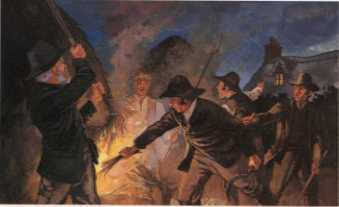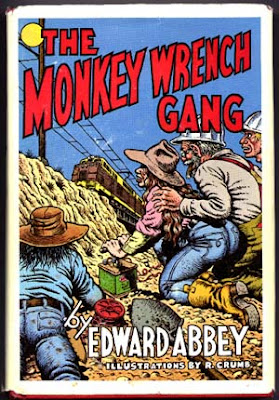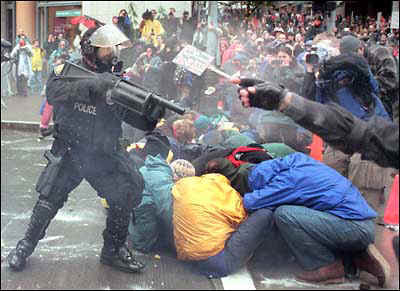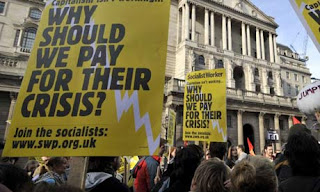Anyone who's walked down Glastonbury High Street, otherwise known as Diagon Alley, immediately knows that this is no ordinary English market town.
Apparently when the current
King Arthur Pendragon first "came out" and turned up in the town complete with Excalibur to announce his reincarnation he was told he was the second one that day.
Despite being the site of an dissolute monastery, a hill topped with a medieval tower and a natural spring pumping forth reddish water, there was little to suggest the sleepy Somerset town would eventually become "
the spaghetti junction of the spiritual journey" (Stone) until late Victorian time.
Then in 1886 efforts were made to restore the Tor and open the Abbey to visitors. At the same time stories that Joseph or Arimathia had hidden the Cup from the Last Supper somewhere nearby started to circulate and the place became popular with Christian mystics.
As the nineteenth century was drawing to a close, a certain Dr Goodchild, following a vision, allegedly purchased an antique glass bowl in Italy and buried it in a muddy field near Glastonbury, where it was recovered by fellow mystics six years later (Benham).
After that things developed rapidly. The recovered Chalice took up home at the newly restored chalice well, now owned by the Christian Socialist Alice Buckton, and a community of esoteric people took up residence in the town. Others dropped by for the Glastonbury Festival, which was started in 1914 by the Atheist Socialist Rutland Boughton, took a break for the Great War, and then ran three times a year from 1920.
Supposedly there were long haired bohemians, advocates of free love, spiritualists and vegetarians, who were rumoured to visit the Tor after dark, get their kit off, and engage in idolatrous pagan rituals. Your regular night at the Moot really.
Avalon of the Heart by Dion Fortune (1930)
The chief chronicler of these early days wasn't one of the locals, but a weekender who popped over from London every now and again.
Violet Mary Firth Evans, alias Dion Fortune, said her regular journey from London, past Avebury and Stonehenge, "
spans the breadth of England and leads from one world to another".
Her classic book paints a spiritual landscape that dates back to before "
the era when the worship of the Son replaced that of the Sun." For Fortune the Abbey was for the Christians and the Chalice Well for the Pagans, with the Tor itself belonging to both.
Lovingly she paints a portrait of the town, a place where the veil is thin and where echoes of an ancient past reverberate in the quiet waters of Chalice Well or the still air atop the Tor.
Possibly because she never lives there, her Avalon is described as a place apart from the mundane world she leaves behind, and the book climaxes with a performance of
The Immortal Hour at Boughton's festival.
King Arthur's Avalon: The Story of Glastonbury by Geoffrey Ashe (1957)
Boughton's Glastonbury Festivals came to an end in 1926, and it seemed that with that the sun started to sink on the embryonic New Age scene in the town. However things were starting to stir in the academic realms of Arthurian studies.
Arthur had been going downhill for a century or so, being relegated from a bona fida Welsh hero to a shadowy form haunting the unknown regions of the Dark Ages. In 1936 one Professor Collingham tried to set him up as a Late Roman cavalryman, but the idea foundered on a lack of evidence.
Such problems though did not hold back the Christian mystic Geoffrey Ashe when he set forth his views in this the first of many books on the subject. Hitherto the Welsh had Arthur resident in Caerleon, and the historians tended to have him further north, but Ashe put him squarely where the old monks had had him.
Their story of digging up his bones in 1192 had generally been regarded as bit of English colonial propaganda, stealing Wales's national hero in order to keep down the rebellious Celts across the Bristol Channel.
Ashe though, using the ruse that if it can't be conclusively proven to be false then it must be true, took the story and added to it, setting the whole Matter of Britain more or less within sight of the Tor.
Academics tolerated the book, and when Ashe persuaded renowned archaeologist Leslie Alcock to dig up nearby Cadbury Castle, the resulting finds of a Dark Age fortress further added to the story.
A posse of academics eventually rounded on Ashe and his woolly reasoning and he departed Britain for the more convivial atmosphere of the USA, but for Arthur it didn't matter. He was now back in Avalon.
The View Over Atlantis by John Michell (1969)
Alfred Watkins is generally credited with the discovery, or invention, of Ley Lines. But whilst it's true that his 1921 book,
The Old Straight Track, was a minor sensation and had people striding out across the countryside in search of ancient monuments, but there was never anything mystic about Watkins's idea of how ancient Brits got about and it was pretty soon forgotten.
The View Over Atlantis is
The Old Straight Track on acid. No longer are Ley Lines there simply to get Bronze Age man home for tea, now they are channels of energy that thread their way around the planet. And at the hub of the radiating orgone energy was Glastonbury.
Visiting Glastonbury last year I struggled to find a second hand copy in the local bookshops, but about half of what they did sell has its origins in this book and Michell can probably claim to rate up there with John Lennon and Jefferson Airplane as someone who helped define what it meant to be a hippy.
That what he actually put in the book is pretty much wrong is really neither here nor there. Michell himself said "
like all discoveries at Glastonbury, it came through revelation, which is not a popular medium among the professors" - which may be understating it a little.
People had seen shapes in the landscape before. Doctor John Dee apparently found some sort of Zodiac and Dr Goodchild thought he'd seen the outline of a giant fish, but Michell, by splicing in Aboriginal 'song lines' and Chinese 'dragon lines' along with lashing of sacred geometry, expanded the idea exponentially.
The result was "
a poetic rather than a scientific truth", but it was enough to touch off a mystical quest that opened the doors of perception for a lot of people.
Mysterious Britain by Janet and Colin Bord (1972)
Two years after Michell's book came out Michael Eavis relaunched the Glastonbury festivals on his farm in Pilton. Fairport Convention, Gong, Hawkwind and Arthur Brown played on the main stage, which was a pyramid built on a ley line based, after a phone consultation with Michell, on the proportions of Stonehenge.
But the tastes of the audience extended well beyond Michell's spiritual engineering and the Bords's book, which came out the next year reflected this smorgasbord of hitherto distinct subjects.
Ley Lines were there, although the Bords noticed that many didn't actually touch the monuments they were actually supposed to be aligned with - which they put down to respect for their sanctity.
Added into the mix though were UFOs, which were so popular at that time that the Glastonbury Fayre had a space set aside for them to land, as well as stone circles and holy wells, ghosts and King Arthur. The Bords also included local customs that had been interpreted rightly or wrongly (usually wrongly) by folklorists as pagan survivals.
Here then is the true Re-enchantment of Britain. UFOs have now mostly been dropped, but the publication of similar books persists - and it seems I own most of them.
Mists of Avalon by Marion Zimmer Bradley (1986)
Thanks to Michell and the Bords the seventies saw the New Age arrive in the town in force.
At first the locals were a bit standoffish and "No Hippies" signs adorned many of the B&Bs and hostelries. Gradually though the barriers came down and peaceful coexistence was the order of the day.
The scene was very nearly complete by the end of the decade, and all it required was one great book to bring it all together.
Marion Zimmer Bradley turned out to be the author.
The role of the female in spirituality had been a theme of the developing Glastonbury New Age scene, from the trio of lady occultists that Goodchild put in charge of the Chalice, to the feminists who attended the festival.
Bradley wove this into the Matter of Britain, giving us three strong and complex female characters in Egraine, Guinevere and most of all Morgan Le Fey, contrasted with a weak Arthur, first seen as an incontinent toddler needing his older sister's care.
In Bradley's Avalon, the Christians live in harmony with the deeper mysteries known only to the Priestesses of Avalon, and whilst Merlin drops by occasionally he is at most the equal of the Lady of the Lake.
It had been a long journey from a good Doctor dropping an old cup in a muddy pool. I suspect that Goodchild would not approve of the commercialism of modern Glastonbury, and may wonder where his Christian mysteries are now. But I suspect he would like
Mists of Avalon and approve of Bradley, a woman who wrote of the sacred female but who died a Christian, and whose ashes now rest on the Tor.
References
The Avalonians by Patrick Benham (1993).
The Last of the Hippies by C J Stone (1999)
Glastonbury: A Very English Fair by George McKay (2000)
Witches, Druids and King Arthur by Ronald Hutton (2006)
 Two hundred years ago today the well known womaniser and occasional poet Lord Byron made his maiden speech in the House of Lords.
Two hundred years ago today the well known womaniser and occasional poet Lord Byron made his maiden speech in the House of Lords. Because of this devotion to death we know very little about the Luddites. Those who told their story did not do so for another 50 years when, in the age of the Chartists and the first Trade Unions, they were happy to style themselves early Working Class heroes.
Because of this devotion to death we know very little about the Luddites. Those who told their story did not do so for another 50 years when, in the age of the Chartists and the first Trade Unions, they were happy to style themselves early Working Class heroes. Even the Luddite's name is a mystery.
Even the Luddite's name is a mystery. In Geoffrey of Monmouth's 12th century classic History of the Kings of Britain, the book that gave us King Lear and which first merged the stories of Arthur and Merlin, we have the story of the Three Plagues of Lud's Town. Here the king fights off spectral foes and in turns gives his name to the town that became London.
In Geoffrey of Monmouth's 12th century classic History of the Kings of Britain, the book that gave us King Lear and which first merged the stories of Arthur and Merlin, we have the story of the Three Plagues of Lud's Town. Here the king fights off spectral foes and in turns gives his name to the town that became London.






















